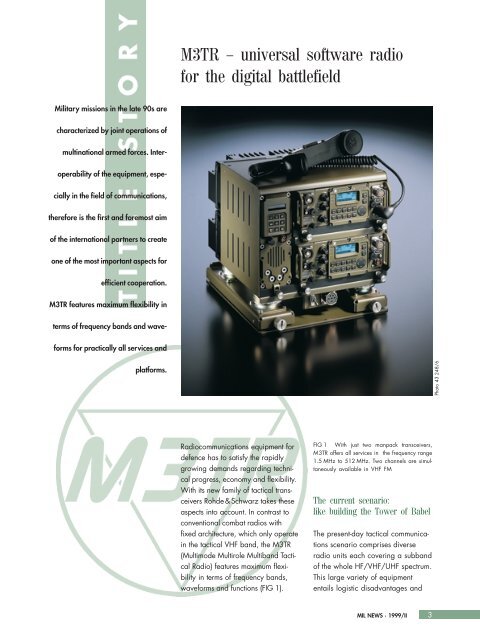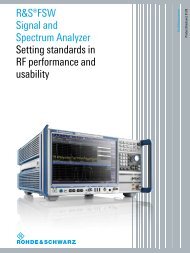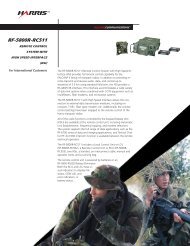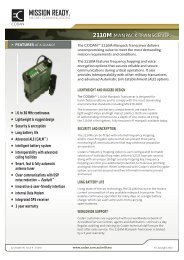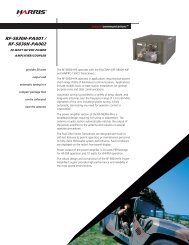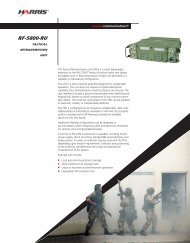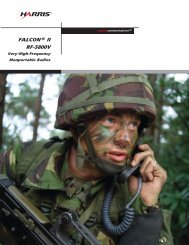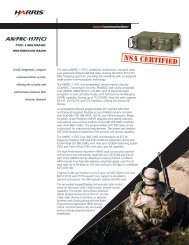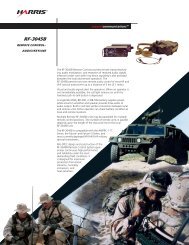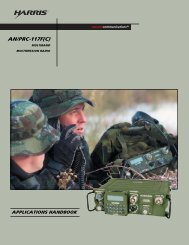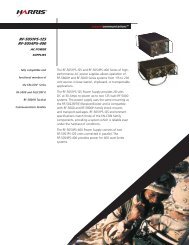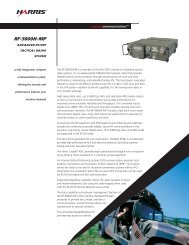M3TR â universal software radio for the digital battlefield
M3TR â universal software radio for the digital battlefield
M3TR â universal software radio for the digital battlefield
You also want an ePaper? Increase the reach of your titles
YUMPU automatically turns print PDFs into web optimized ePapers that Google loves.
<strong>M3TR</strong> – <strong>universal</strong> <strong>software</strong> <strong>radio</strong><br />
<strong>for</strong> <strong>the</strong> <strong>digital</strong> <strong>battlefield</strong><br />
Military missions in <strong>the</strong> late 90s are<br />
characterized by joint operations of<br />
multinational armed <strong>for</strong>ces. Interoperability<br />
of <strong>the</strong> equipment, especially<br />
in <strong>the</strong> field of communications,<br />
<strong>the</strong>re<strong>for</strong>e is <strong>the</strong> first and <strong>for</strong>emost aim<br />
of <strong>the</strong> international partners to create<br />
one of <strong>the</strong> most important aspects <strong>for</strong><br />
efficient cooperation.<br />
<strong>M3TR</strong> features maximum flexibility in<br />
terms of frequency bands and wave<strong>for</strong>ms<br />
<strong>for</strong> practically all services and<br />
plat<strong>for</strong>ms.<br />
Photo 43 248/6<br />
Radiocommunications equipment <strong>for</strong><br />
defence has to satisfy <strong>the</strong> rapidly<br />
growing demands regarding technical<br />
progress, economy and flexibility.<br />
With its new family of tactical transceivers<br />
Rohde & Schwarz takes <strong>the</strong>se<br />
aspects into account. In contrast to<br />
conventional combat <strong>radio</strong>s with<br />
fixed architecture, which only operate<br />
in <strong>the</strong> tactical VHF band, <strong>the</strong> <strong>M3TR</strong><br />
(Multimode Multirole Multiband Tactical<br />
Radio) features maximum flexibility<br />
in terms of frequency bands,<br />
wave<strong>for</strong>ms and functions (FIG 1).<br />
FIG 1 With just two manpack transceivers,<br />
<strong>M3TR</strong> offers all services in <strong>the</strong> frequency range<br />
1.5 MHz to 512 MHz. Two channels are simultaneously<br />
available in VHF FM<br />
The current scenario:<br />
like building <strong>the</strong> Tower of Babel<br />
The present-day tactical communications<br />
scenario comprises diverse<br />
<strong>radio</strong> units each covering a subband<br />
of <strong>the</strong> whole HF/VHF/UHF spectrum.<br />
This large variety of equipment<br />
entails logistic disadvantages and<br />
MIL NEWS · 1999/II 3
FIG 2<br />
With just two units, <strong>the</strong> <strong>M3TR</strong> transceiver<br />
family covers <strong>the</strong> whole spectrum from shortwave<br />
through to UHF, thus providing interoperability<br />
and uni<strong>for</strong>m interservice logistics<br />
30<br />
300 3000 MHz<br />
HF VHF UHF<br />
poor interoperability between <strong>the</strong><br />
equipment of friendly nations, eg<br />
within UN missions.<br />
Different communications standards<br />
exist even within NATO and new<br />
ones are being prepared. Examples<br />
are HAVE QUICK I and II, <strong>the</strong> future<br />
SATURN <strong>for</strong> UHF or STANAG 4444<br />
<strong>for</strong> <strong>the</strong> shortwave band, as well as<br />
agreements evolving from <strong>the</strong> multinational<br />
TACOMS POST 2000 study.<br />
Worldwide however, proprietary<br />
wave<strong>for</strong>ms or export models that<br />
cannot communicate with each o<strong>the</strong>r<br />
or with restrictions only are predominantly<br />
used.<br />
<strong>M3TR</strong> <strong>software</strong> <strong>radio</strong> with its open<br />
architecture is a broadband and<br />
interservice communication medium<br />
that can easily be adapted to<br />
present and future applications and<br />
wave<strong>for</strong>ms.<br />
The solution with <strong>the</strong> triple “M”:<br />
… Multiband<br />
The fixed allocation of frequency<br />
bands and services, eg combat net<br />
<strong>radio</strong> in <strong>the</strong> range from 30 MHz to<br />
88 MHz or air defence from<br />
225 MHz to 400 MHz, makes it evident<br />
that <strong>the</strong> multirole features of a<br />
<strong>radio</strong> unit can only be implemented<br />
in conjunction with multiband capabilities.<br />
For applications making use<br />
of various services and networks,<br />
two or more independent <strong>radio</strong> units<br />
were previously required. With just<br />
two units (MR3000H and MR3000U),<br />
<strong>the</strong> <strong>M3TR</strong> transceiver family covers<br />
1.5<br />
30<br />
HF/VHF FM: 1.5 to 108 MHz<br />
<strong>the</strong> whole spectrum from shortwave<br />
through to <strong>the</strong> UHF band, thus providing<br />
interoperability and uni<strong>for</strong>m<br />
interservice logistics (FIG 2).<br />
… Multimode<br />
Thanks to optimized protocols and<br />
wave<strong>for</strong>ms <strong>M3TR</strong> attains high data<br />
rates <strong>for</strong> <strong>digital</strong> voice, realtime video<br />
and visual display data. In command<br />
systems this allows among o<strong>the</strong>rs<br />
automated data exchange, <strong>for</strong><br />
instance <strong>for</strong> online position display<br />
and distribution. With P 3 I (preplanned<br />
product improvement) even<br />
future and planned methods can subsequently<br />
be integrated in <strong>the</strong> equipment<br />
through <strong>software</strong> upgrades. An<br />
integrated GPS module synchronizes<br />
on demand <strong>the</strong> system time of <strong>the</strong><br />
EPM-protected <strong>radio</strong> circuits and furnishes<br />
<strong>the</strong> current position of <strong>the</strong><br />
<strong>radio</strong> operators. These data can be<br />
transmitted manually or automatically<br />
to <strong>the</strong> higher-level command system.<br />
For optimal utilization of <strong>the</strong> available<br />
frequencies, data and voice can be<br />
transmitted simultaneously in a physical<br />
channel. <strong>M3TR</strong> provides <strong>for</strong> this<br />
purpose a special packet data protocol<br />
which on request automatically inserts<br />
voice packets into <strong>the</strong> transmission<br />
channel. Moreover, SECOS provides<br />
a TDMA access method <strong>for</strong><br />
data transmission in <strong>the</strong> UHF band.<br />
108 118 137 225 400<br />
MR3000H<br />
VHF FM/VHF/UHF: 25 to 512 MHz<br />
Data rates (FEC-protected) of<br />
5.4 kbit/s in <strong>the</strong> shortwave band and<br />
of up to 64 kbit/s in <strong>the</strong> VHF/UHF<br />
band can be achieved with a bandwidth<br />
of no more than 25 kHz [1].<br />
… Multirole<br />
MR3000U<br />
MHz<br />
<strong>M3TR</strong> offers comprehensive multirole<br />
features allowing its easy integration<br />
into tactical communication networks<br />
(FIG 3). In addition to its use<br />
as a functional terminal in <strong>the</strong> respective<br />
subnet, eg CNR (combat<br />
net <strong>radio</strong>) or PRN (packet <strong>radio</strong><br />
net), <strong>M3TR</strong> can also act as an interface<br />
between <strong>the</strong> individual subnets.<br />
Manpack Transceiver<br />
MR3000, <strong>for</strong> instance, can be used<br />
as a <strong>radio</strong> component in a RAP (<strong>radio</strong><br />
access point) which establishes<br />
<strong>the</strong> interface to fixed networks such<br />
as ISDN/PSTN, LAN and WAN.<br />
<strong>M3TR</strong> is suitable <strong>for</strong> portable use as<br />
well as <strong>for</strong> use on all mobile plat<strong>for</strong>ms<br />
and, in addition to <strong>the</strong> above<br />
interfaces, also provides intelligent<br />
gateway and relay functions. <strong>M3TR</strong><br />
is not restricted to use in strictly<br />
military networks: by loading <strong>the</strong><br />
appropriate <strong>software</strong> <strong>the</strong> transceivers<br />
can be used as terminals in<br />
civilian PMR (professional mobile<br />
<strong>radio</strong>) networks. Implementation of<br />
<strong>the</strong> latest ETSI standard TETRA25 is<br />
planned.<br />
4<br />
MIL NEWS · 1999/II
EPM – protection of communication<br />
by frequency hopping<br />
and encryption *<br />
In all military applications <strong>the</strong> effective<br />
protection against interception<br />
and jamming is in <strong>the</strong> <strong>for</strong>eground. In<br />
addition to <strong>the</strong> EPM (electronic protection<br />
measures) standard method<br />
SECOM specially developed <strong>for</strong><br />
<strong>M3TR</strong>, <strong>the</strong> NATO methods HAVE<br />
QUICK I and II, SATURN as well as<br />
SECOS <strong>for</strong> ground-to-air communication<br />
are also incorporated. O<strong>the</strong>r national<br />
or proprietary standards such<br />
as SINCGARS, PR4G, SEM, etc, can<br />
be integrated if required.<br />
The newly developed SECOM with<br />
its extremely high hop rates and secure<br />
synchronization method in <strong>the</strong><br />
HF and VHF bands is setting standards.<br />
Within an EPM net, several orthogonal<br />
sublinks can simultaneously<br />
be established in point-to-point,<br />
point-to-multipoint and broadcast/<br />
multicast mode. The system responds<br />
fully adaptively (intelligent hopping)<br />
or via a preset threshold (mixed<br />
mode) to dynamic changes in channel<br />
availability and network quality.<br />
Intelligent hopping means <strong>the</strong> continuous<br />
checking of <strong>the</strong> quality of <strong>the</strong><br />
employed frequencies and elimination<br />
of jammed channels from <strong>the</strong><br />
network. Mixed mode denotes that<br />
* See also article on page 24 of this issue,<br />
describing <strong>the</strong> INFOSEC module <strong>for</strong> <strong>M3TR</strong><br />
FIG 3 <strong>M3TR</strong> <strong>software</strong> <strong>radio</strong> not only allows<br />
flexible integration into tactical communication<br />
networks but can also act as an interface between<br />
various networks<br />
RAP<br />
TETRA<br />
REN<br />
ATM<br />
CNR<br />
Radio Access Point<br />
Terrestrial Trunked Radio<br />
Range Extension Node<br />
Asynchronous Transfer Mode<br />
Combat Net Radio<br />
TACOMS (ATM)<br />
RAP<br />
Wide Area Subsystem (WAS)<br />
TACOMS (ATM)<br />
RAP<br />
Local Area Subsystem A (LAS)<br />
RAP<br />
REN<br />
CNR<br />
RAP<br />
Packet Radio Net<br />
Local Area Subsystem B (LAS)<br />
TETRA – Digital Trunked Radio Net<br />
MIL NEWS · 1999/II 5
at a certain percentage of jammed<br />
frequencies (eg 20%) automatic<br />
switchover is made from <strong>the</strong> hopping<br />
mode to <strong>the</strong> FCS (free channel<br />
search) mode.<br />
Network synchronization and access<br />
can be planned and controlled individually<br />
<strong>for</strong> each user. Methods like<br />
late net entry, break-in and hailing<br />
are available <strong>for</strong> this purpose.<br />
The COMSEC part of <strong>the</strong> SECOM<br />
EPM method is based on <strong>the</strong> RSCA<br />
cryptoalgorithm developed by<br />
Rohde & Schwarz. The method uses<br />
key lengths of up to 256 bits (approx.<br />
10 77 variants). Assuming uninterrupted<br />
transmission, <strong>the</strong> same bit<br />
sequence would be repeated after<br />
about 2 x 10 9 years. The keys required<br />
<strong>for</strong> <strong>the</strong> EPM method can be<br />
distributed by means of a KDD (key<br />
distribution device) or via OTAR<br />
(over-<strong>the</strong>-air rekeying). Prior to OTAR<br />
all keys are multiply encrypted and<br />
<strong>the</strong> non-encrypted original is saved<br />
in <strong>the</strong> read-protected security processor<br />
only.<br />
The COMSEC part also features<br />
open architecture. Crypto units to<br />
NATO standards or from o<strong>the</strong>r manufacturers<br />
may be used as an external<br />
option, whereas NATO encryption<br />
methods can directly be integrated<br />
in <strong>the</strong> transceiver.<br />
Communication management – a<br />
must with complex configurations<br />
Planning of <strong>radio</strong> networks, in particular<br />
those with EPM, with manual<br />
methods is possible <strong>for</strong> a few operators<br />
only, if at all. The use of computer-aided<br />
planning tools is indispensable<br />
<strong>for</strong> complex configurations.<br />
Rohde & Schwarz <strong>the</strong>re<strong>for</strong>e offers a<br />
planning and management <strong>software</strong><br />
optimized <strong>for</strong> <strong>M3TR</strong>. It consists of<br />
<strong>software</strong> modules <strong>for</strong> key, frequency<br />
and network management as well as<br />
modules <strong>for</strong> <strong>the</strong> configuration of terminals<br />
and <strong>the</strong> distribution of device<br />
data. It supports <strong>the</strong> following applications:<br />
<br />
<br />
<br />
<br />
<br />
<br />
<br />
Network configuration (address<br />
management)<br />
Programming of terminals<br />
Frequency planning <strong>for</strong> overall<br />
networks and subnetworks<br />
Security management<br />
Mission planning<br />
Time planning<br />
Data distribution to terminals<br />
The configuration data can be transmitted<br />
via any of <strong>the</strong> <strong>M3TR</strong> data interfaces,<br />
by means of a fill gun<br />
(loadable buffer memory) or even<br />
via <strong>the</strong> air interface by means of<br />
OTAM (over-<strong>the</strong>-air management).<br />
The link establishment to <strong>the</strong> transceivers<br />
thus set up is <strong>the</strong>n convenient<br />
and easy. The operator chooses a<br />
mode (network) and activates <strong>the</strong><br />
push-to-talk key or data transmission<br />
mode on <strong>the</strong> terminal. Everything<br />
else is done automatically.<br />
With <strong>M3TR</strong> communication becomes<br />
ever so easy – and <strong>the</strong>re are no<br />
bounds to it.<br />
Ulrich Otto<br />
REFERENCES<br />
[1] SECOS EPM system <strong>for</strong> <strong>the</strong> three <strong>for</strong>ces.<br />
MIL NEWS from Rohde& Schwarz (1999)<br />
No. 2, pp 12– 14<br />
<strong>M3TR</strong> – specs and facts<br />
The two Manpack Transceivers MR3000H<br />
and MR3000U providing seamless coverage<br />
of <strong>the</strong> transmission range from<br />
1.5 MHz to 108 MHz (model H) and from<br />
25 MHz to 512 MHz (model U) <strong>for</strong>m <strong>the</strong><br />
core of <strong>the</strong> <strong>M3TR</strong> transceiver family. Both<br />
units are designed <strong>for</strong> reception from<br />
1.5 MHz to 512 MHz. Despite <strong>the</strong> high<br />
processing power – one central processor<br />
(RISC), two DSPs and up to two crypto<br />
processors – battery operation of up to<br />
57 hours is ensured by effective power<br />
management. A total storage capacity of<br />
25 Mbyte allows up to 99 presets including<br />
several EPM methods to be saved<br />
simultaneously. The presets store all variable<br />
parameters of <strong>the</strong> selected method,<br />
such as hopsets, modulation modes and<br />
addressing.<br />
Installation kits comprising one or two transceivers<br />
plus extras are available <strong>for</strong> mobile<br />
and stationary use. The 10 W RF output<br />
power of <strong>the</strong> manpack (20 W HF) can be<br />
boosted to 50 W (up to 400 W HF) using<br />
compact amplifiers. Frequency-hop-compatible<br />
co-site filters in command vehicles<br />
ensure interference-free parallel operation<br />
of several lines. An optional switching unit<br />
provides interfaces <strong>for</strong> practically all landbased<br />
communication networks. Connections<br />
to ISDN/PSTN, TCP/IP, UDP as well<br />
as to serial and optical interfaces <strong>for</strong> data<br />
terminals are <strong>the</strong>re<strong>for</strong>e supported. Fur<strong>the</strong>rmore<br />
<strong>the</strong>re are comprehensive remote-control<br />
capabilities. The RC unit has <strong>the</strong> same<br />
MMI as <strong>the</strong> remote-controlled transceiver<br />
and can be sited several kilometers away.<br />
All settings of <strong>the</strong> active transceiver are<br />
copied to <strong>the</strong> RC unit.<br />
Are that many technical features portable<br />
Without any doubt: <strong>the</strong> manpack model of<br />
MR3000 weighs as little as 3.5 kg, with a<br />
volume of less than 3.5 liters. If this is<br />
thought to be still on <strong>the</strong> high side, <strong>the</strong> control<br />
unit can be detached from <strong>the</strong> transceiver<br />
and set up at a distance of max.<br />
3 m: ideal <strong>for</strong> portable use or easy installation<br />
in vehicles.<br />
6<br />
MIL NEWS · 1999/II


